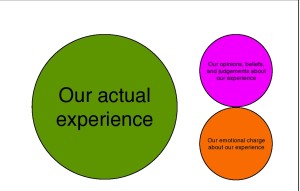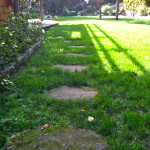We’re living in a period in history where we’re paralyzed by the fear of some impending doom. Our 24-hour news cycle will have us believe that there are more wars and violent deaths than ever. But we are actually living in an unusually calm time. The odds of us dying violently are low and getting lower. We also keep hearing scary economic data. And while there’s no doubt we’ve been living in a trying economic period since 2008, we’re also living in one of the most prosperous periods in history. Fear sells newspapers. It also has the nasty side effect of paralyzing us. We end up sticking with stuff that, while, on the one hand, feels safe, on the other hand, sucks the life out of us, be it a job or a relationship. It makes us afraid of change.
Playing It Safe
And then we have all sorts of justifications we tell ourselves for why we should just “suck it up.” Most of the clients that show up at my office have a self-critical voice inside that tells them that they should just be grateful for what they have. “At least I’m not out on the streets.” But often, they’re just playing it safe. They’re doing fine, but they’re disconnected from an experience of life that’s vivid, alive, and meaningful.
By fearing risk, something in them has died. One client who sought coaching with me used to come home from work everyday, pour herself a glass of wine, and make love to her channel changer instead of the man of her dreams she was dying to meet. While she didn’t particularly enjoy the time in front of the television, at least she didn’t have to face rejection.
As a coach, I can’t do much when someone has given up. There has to be a hunger in there somewhere, even if it’s buried in avoidance. Sometimes that hidden and elusive hunger demands that my clients be willing to dive down, through the experience of fear, through panic, and through layers of discomfort. It’s often at the bottom of this journey downward that my clients discover a gem in the form of wisdom, clarity, and creativity. When the client I described above reached her bottom, she realized, “I’m scared that it’ll be too much work to try to find someone, but I am even more scared of what my life will look like 10 years from now if I don’t try.” Hitting bottom woke her up to the recognition that she wasn’t preordained to be a recluse. She was choosing it.
The Calling
So she traded in her remote control for a yoga mat and a membership to the studio down the street. “Who knows? Maybe I’ll meet him in class.” When we have the courage to take the one step in a direction that might be fun, engaging, and just a little scary, we’re reminded that risk brings vibrancy to life. That it’s a little scary can be a really good thing. When we choose something that is both exciting and just a little uncomfortable, we start to move out of paralysis and toward aliveness. Whether it’s a yoga class, quiet time in nature, or a workshop, it can be extremely helpful to shake things up, to get out of our routines in order to be reminded of who we are and what we’re made of.
We all come into the world with a hunger and zest for aliveness, but it’s often been taken from us by the expectations of others. Mainly when I get the call for a introductory coaching session, the person on the other line can sense that they’ve been called to something else or something greater, but what that is isn’t clear. Sometimes this recognition comes in the form of illness, depression, or anxiety. Sometimes, it’s just a low grade, nagging feeling that they have something important to get to in their lives but can’t see it clearly. Sometimes, it’s clear as day, but the path getting there is fraught with pitfalls, and they can’t see the way through.
T.S.O.
The only way that it can get clearer is if we take just one step forward. And sometimes, just taking that step can be like pulling teeth because we’ve already thought our way to the end, and it looks very scary. Poet, David Whyte, offers pithy instruction for this tendency to over strategizing in his poem, Start Close In:
Start close in, don't take the second step or the third, start with the first thing close in, the step you don't want to take.
Start with the ground you know, the pale ground beneath your feet, your own way of starting the conversation.
Sometimes it requires that we just take the step that’s in front of us. I watch some clients giving too much weight to having a plan. I am not suggesting that it’s worthless to have a plan, but rarely does a path follow a straight trajectory except, of course, when we look in hindsight. Mainly, we have to have the courage to just take that one step that’s in front of us, the one we’re afraid to take but equally the one we know we need to take.
The technical term I use for one mode of stepping forward that I teach my clients is called, “T.S.O.-ing,” or Trying Shit Out. Taking that leap into action sometimes calls for 3 parts balls, 1 part throwing caution to the wind, and a dash of “f**k it.” That step demands that we let go of what we think we know. It demands that we be willing to concede mistakes. Often it requires we be willing to just give it a try.
Giving Up Victimhood
That step is a form of reckoning; it requires us to own our hunger and the journey it takes us on. It forces us to defeat the fears that we might not have what it takes-- the guts, the smarts, or the stamina—to make it to the finish. Once we’ve taken it, we no longer have anyone to blame for our paralysis, not our cruel boss, not our absent father, or the balance in our bank account. When we take that one uncomfortable, sometimes painful, yet authentic step, we have to give up our victim stance. It won’t serve us on that journey.
We also have to be willing to withstand long periods of discomfort, of not knowing the outcome but not so long that we’re pigheaded. And that’s a fine dance. It seems to me, though, that most of us could use a little stick-to-it-ive-ness. We’re often willing to live in atmospheres that are simultaneously empty and combative, but for some reason it’s really hard to stay with something that means a lot to us. Neurobiologists tell us that we’re not wired to do this. We’re wired to avoid change because it actually hurts. The brain does not distinguish between physical or psychological pain. We have to be willing to stay with the pain of not knowing the outcome for extended periods of time.
Why Do It Alone?
Given that that one, risky step is so laden with fear, doubt, and all the stuff that comes up when we put ourselves on the line, it can’t hurt to have community and individual support. We are, by nature, social creatures, no matter how introverted some of us are. We need others. We live in a culture that has historically valued people with gumption who make it to the top through sheer willfulness. We rarely hear about the Bela Karolyi’s that help form the Nadia Comăneci’s. Nadia did it, but she didn’t do it alone. Sometimes the mentor comes in the form of a historical figure, like Mohandas Gandhi for Martin Luther King, Jr. Sometimes, it comes in the form of a teaching or a teacher like Gautama Buddha or Jesus.
However it comes, the direct experience of being met in our hunger and acknowledged for it is absolutely life affirming. It connects us to something we know, something that is much bigger than us, and reminds us to wonder, to stay in curiosity, and to continue to struggle with the journey we feel called to. The friend, ally, or teacher can’t do it for us, but they can help us frame the path in such a way that it makes sense and, at the same time, helps us stay connected to what’s important.
This is where coaching can be useful. As coaches, we’re trained to want what our clients want. Instead of wanting what we want, most people we’re close to, in fact, want what they want for us. The distinction I am making here is that most everybody else thinks that they know what’s best for us. But they don’t. How could they? Someone who comes from a reputable coach training holds their clients as experts and, instead of telling them what they should want and do, asks powerful questions that evokes the learning necessary to forward action. Additionally, a good coach will hold his/her client accountable for the action, since we all have a tendency to talk good games without much follow through.
Be the Change
This is a time of great change, politically, socially, globally, environmentally, economically and so much more. The old systems that worked at one time, no longer work. As a coach, I get that I’m about to be trite when I say that Gandhi had it right when he said, “Be the change you want to see in the world.” The bottom line is that we’re it. The political system won’t change until we’ve changed, nor will the economic, environmental, social, or any other. You and I ARE the system. And its brokenness is only reflecting to us our own brokenness.
Until we’ve become tired of waiting for Santa Clause to come down the chimney; until we wake up to the fact that there will never be enough money in the bank; and until we’re willing to step up to the plate and claim our hunger and take that first step, we’ll remain, at best, innocent bystanders, or, at worst, the cause of the ever increasing decay we see around us. In short, it’s critical that we, as a species, wake up to what authentically moves us. It’s my hunch that that’s what will transform the situation we all face. And it starts with us, you and me. And it starts, now. And now. And now.
[gravityform id="2" name="Free consultation"]








